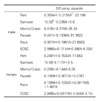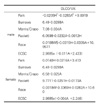Abstract
Background
The lung volume and diffusing capacity are influenced by ethnicity. However, there are no equations for predicting the normal lung volume in the adult Korean population, and there is only one equation for diffusing capacity. The aim of this study is to select the most suitable reference equation for the Korean population.
Method
30 men and 33 women at Hanyang University Guri Hospital, and 27 men and 34 women at Asan Medical Center in healthy nonsmoking adults were enrolled in this study. The subject's age, gender, height, weight, lung volume by plethysmography, and diffusing capacity by a single breathing method were obtained. The most suitable equation with the lowest sum of residuals between the observed and predicted values for lung volume and diffusing capacity was selected.
Result
At Hanyang University Guri Hospital, the equations with the lowest sum of residuals in the total lung capacity were ECSC's equation in males (sum of residual: 0.04 L) and Crapo/Morris's equation (-1.04) in women. At the Asan Medical Center, the equations with the lowest sum of residuals in the total lung capacity were Goldman/Becklake's equation in males (sum of residual: -2.35) and the ECSC's equation -4.49) in women. The equations with the lowest sum of residuals in the Diffusing capacity were Roca's equation in males (sum of residual: -13.66 ml/min/mmHg) and Park's in women (25.08) in Hanyang University Guri hospital and Park's equation in all cases in the Asan Medical Center (male: -1.65 , female: -6.46).
Figures and Tables
Figure 1
Scatter of Residuals in total lung capacity
Figure 1 shows residuals of ECSC's equations that had the lowest sum of residual in total lung capacity at Hanyang university Guri Hospital and Asan Medical Center.

Figure 2
Scatter of Residuals in DLCO
Figure 2 shows residuals of Park's equations that had the lowest sum of residual in diffusing capacity at Hanyang University Guri Hospital and Asan Medical Center.

References
1. Kim WD, Koh YS, Kim DS, Kim WS, Kim WS, Shim TS, et al. Pulmonary function test. 2005. 1st ed. Seoul: UUP;7–82.
2. Quanjer PH, Tammeling GJ, Cotes JE, Pedersen OF, Peslin R, Yernault JC. Lung volumes and forced ventilatory flows. Eur Respir J Suppl. 1993. 16:5–40.
3. Quanjer PH. Standardization of lung function tests. Bull Eur Physiopathol Respir. 1983. 19:Suppl 5. 1–82.
4. Knudson RJ, Bloom JW, Knudson DE, Kalteborn WT. Subclinical effects of smoking. Chest. 1984. 86:20–29.
5. Cordero PJ, Morales P, Benlloch E, Miravet L, Cebrain J. Static lung volumes: reference values from a Latin population of Spanish descent. Respiration. 1999. 66:242–250.
6. Hall AM, Heywood C, Cotes JE. Lung function in healthy British women. Thorax. 1979. 34:359–365.
7. van Gause WF, Ferris BG Jr, Cotes JE. Cigarette smoking and pulmonary diffusing capacity (Transfer factor). Am Rev Respir Dis. 1972. 105:30–41.
8. Frans A, Stanescu DC, Veriter C, Clerbaux T, Brasseur L. Smoking and Pulmonary diffusing capacity. Scand J Resp Dis. 1975. 56:165–183.
9. Marco M, Minette A. Lung function changes in smokers with normal conventional spriometry. Am Rev Respir Dis. 1976. 114:723–738.
10. Yang TS, Peat J, Keena V, Donnelly P, Unger W, Woolcock A. A review of the racial differences in the lung function of normal Caucasian, Chinese and Indian subjects. Eur Respir J. 1991. 4:872–880.
11. Nam SY, Kim KH, Hong YM, Kim GH. Normal predicted values of pulmonary function test in healthy Korean children. J Korean Pediatr Soc. 1998. 41:338–345.
12. Park JO, Choi IS, Park KO. Normal predicted standards of single breath carbon monoxide diffusing capacity of lung in healthy nonsmoking adults. Korean J Med. 1985. 28:176–183.
13. Goldman HI, Becklake MR. Respiratory function tests: normal values at median altitudes and the prediction of normal results. Am Rev Tuberc. 1959. 79:457–467.
14. Crapo RO, Morris AH, Clayton PD, Nixon CR. Lung volumes in healthy nonsmoking adults. Bull Eur Physiopathol Respir. 1982. 18:419–425.
15. Burrows B, Kasik JE, Niden AH, Barclay WR. Clinical usefuless of the single-breath pulmonary diffusing capacity test. Am Rev Respir Dis. 1961. 84:789–806.
16. Crapo RO, Morris AH. Standardized single breath normal values for carbon monoxide diffusing capacity. Am Rev Repir Dis. 1981. 123:185–189.
17. Paoletti P, Viegi G, Pistelli G, di Pede F, Fazzi P, Polato R, et al. Reference equations for the single-breath diffusing capacity: a cross-sectional analysis and effect of body size and age. Am Rev Respir Dis. 1985. 132:806–813.
18. Stocks J, Quanjer PH. Reference values for residual volume, functional residual capacity and total lung capacity. Eur Respir J. 1995. 8:492–506.
19. Macintyre N, Crapo RO, Viegi G, Johnson DC, van der Grinten CP, Brusasco V, et al. Standardisation of the single-breath determination of carbon monoxide uptake in the lung. Eur Respir J. 2005. 26:720–735.
20. Pellegrino R, Viegi G, Brusasco V, Crapo RO, Burgos F, Casaburi R, et al. Interpretative strategies for lung function tests. Eur Respir J. 2005. 26:948–968.
21. Roca J, Rodriguez-Roisin R, Cobo E, Burgos F, Perez J, Clausen JL. Single-breath carbon monoxide diffusing capacity prediction equations from a Mediterranean population. Am Rev Respir Dis. 1990. 141:1026–1032.
22. Choi JK, Paek DM, Lee JO. Normal predictive of spirometry in Korean population. Tuberc Respir Dis. 2005. 58:230–242.
23. Oh YM, Hong SB, Shim TS, Lim CM, Koh YS, Kim WS, et al. Effect of a new spirometric reference equation on the interpretation of spirometric patterns and disease severity. Tuberc Res Dis. 2006. 60:215–220.




 PDF
PDF ePub
ePub Citation
Citation Print
Print









 XML Download
XML Download